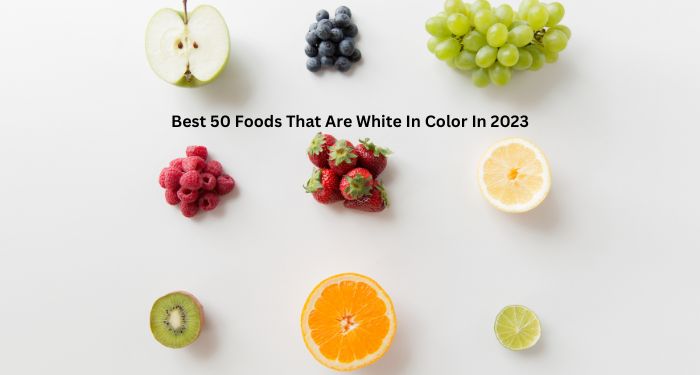Are you looking to add some variety and nutrition to your meals? Look no further than white-colored foods! From fruits and vegetables to grains and proteins, there is an incredible range of white foods that pack a punch when it comes to taste and health benefits. In this article, we will explore the best 50 foods that are white in color, covering everything from familiar favorites to lesser-known gems.
From the crunchy sweetness of cauliflower to the creamy richness of coconut milk, white foods offer a unique culinary experience that is sure to delight your taste buds. Not only are these foods delicious, but they also bring a host of nutritional benefits. For example, white beans are packed with fiber and protein, while garlic is known for its immune-boosting properties. You’ll be pleasantly surprised by the diverse range of options available within the white food category.
Whether you’re a food enthusiast, a health-conscious individual, or simply looking to switch up your menu, this article will provide you with a comprehensive list of the best white foods to incorporate into your diet. Get ready to discover mouthwatering options and experience the incredible flavors and benefits of white-colored foods.
White Fruits and Vegetables
White fruits and vegetables not only add visual appeal to your meals but also offer a range of flavors and textures. Here are some of the best white fruits and vegetables to incorporate into your diet.
Cauliflower:
A versatile cruciferous vegetable often used as a low-carb substitute for rice or mashed potatoes.
White Rice:
Polished rice grains, a staple in many cuisines worldwide, commonly served as a side dish.
Potatoes:
Starchy tubers used in various culinary applications, from fries to mashed potatoes and more.
Coconut:
A tropical fruit with both the flesh and milk used in cooking and baking, adding a unique flavor.
Garlic:
A pungent herb with strong flavor, used in countless savory dishes for its aromatic qualities.
Onions:
Essential aromatic vegetables, used as a base ingredient to add depth to a wide range of dishes.
White Mushrooms:
Commonly enjoyed fungi in cooking for their earthy flavor, available in various varieties.
Parsnips:
Root vegetables with a sweet, nutty flavor, often roasted, boiled, or used in soups.
Tofu:
A protein-rich soybean product with a mild taste, used as a meat substitute in vegetarian dishes.
Jicama:
A crunchy, slightly sweet root vegetable often consumed raw in salads or as a snack.
Fennel:
A bulbous vegetable with a mild licorice-like taste, used raw in salads or cooked in dishes.
Is Peanut Butter Good for Dogs?
White Asparagus:
Milder and more delicate than green asparagus, often enjoyed steamed or grilled.
Coconut Milk:
Extracted from grated coconut, used to add richness and flavor to curries, soups, and desserts.
White Bread:
A basic staple made from refined wheat flour, commonly used for sandwiches and toast.
Greek Yogurt:
Thick and creamy yogurt, high in protein, often eaten alone or with fruits and honey.
White Chocolate:
A confection made from cocoa butter, milk solids, and sugar, distinct from regular chocolate.
Marshmallows:
Soft, sweet treats made from sugar, gelatin, and flavoring, often used in desserts and hot drinks.
Ricotta Cheese:
A creamy Italian cheese, versatile for both savory dishes like lasagna and sweet desserts.
Cottage Cheese:
Fresh cheese with curds, consumed on its own or paired with fruits for a high-protein snack.
Cream Cheese:
Soft and spreadable cheese commonly used as a spread or in desserts like cheesecake.
White Beans:
Varieties like cannellini and navy beans, used in soups, stews, and salads.
TIPS FOR CHOOSING THE RIGHT CEREAL
White Corn:
Used for various purposes, from tortillas to corn-based dishes like cornbread.
Cauliflower Rice:
Finely chopped cauliflower florets used as a low-carb alternative to rice.
White Grapes:
Sweet and juicy grapes with white or pale green skin, enjoyed fresh or made into wine.
Turnips:
Root vegetables with a slightly peppery flavor, used in both cooked and raw dishes.
Coconut Water:
Clear liquid from young coconuts, refreshing and hydrating, often consumed as a beverage.
White Nectarine:
A fragrant stone fruit with white flesh, similar in taste to peaches but less acidic.
Cabbage:
Used in various dishes, from salads and coleslaw to fermented preparations like sauerkraut.
White Sugar:
A common sweetener derived from sugar cane or sugar beets, widely used in baking.
Pears:
Sweet and juicy fruits with a soft texture, available in various varieties with white flesh.
White Peaches:
Fragrant and slightly less acidic than yellow peaches, often enjoyed fresh.
Parsley:
An herb used for garnishing and adding flavor to dishes, often paired with savory foods.
White Onions:
Milder in flavor than yellow onions, used in cooking and raw in salads and salsas.
Macadamia Nuts:
Creamy and buttery nuts often enjoyed as a snack or incorporated into desserts.
White Tea:
Delicate tea made from young tea leaves and buds, prized for its subtle flavor.
Tapioca:
Starch extracted from cassava root, used in puddings and beverages like bubble tea.
Rice Pudding:
A comforting dessert made by simmering rice with milk and sugar until creamy.
Coconut Flour:
A gluten-free flour made from dried coconut pulp, used in various baked goods.
Panna Cotta:
An Italian dessert made by setting sweetened cream with gelatin, often flavored with vanilla.
Cauliflower Cheese:
A dish where cauliflower is baked in a creamy cheese sauce, creating a comforting dish.
Coconut Macaroons:
Sweet treats made from shredded coconut, sugar, and egg whites, often baked until golden.
White Vinegar:
A versatile cooking and condiment ingredient made through fermentation.
Celeriac:
Also known as celery root, this vegetable is used in soups, stews, and as a mashed potato alternative.
Coconut Oil:
Edible oil extracted from coconut meat, used in cooking, baking, and beauty products.
White Miso:
A type of fermented soybean paste used in Japanese cuisine for its umami-rich flavor.
White Fish:
Varieties like cod and haddock, mild-flavored and adaptable for various cooking methods.
Cauliflower Soup:
Creamy soups made by blending cauliflower, often combined with other ingredients.
White Pepper:
A milder form of black pepper, often used to season light-colored dishes.
White Wine:
Alcoholic beverage made from fermented white grapes, enjoyed as a drink or used in cooking.
White Truffle:
A rare and aromatic fungus highly prized in culinary circles, used to elevate dishes with its unique flavor and aroma.
here is also suggesting some Foods That Are White in color from amazon
Nutritional Benefits of White Foods
White foods may not always be the first choice when it comes to vibrant and colorful meals, but they certainly shouldn’t be overlooked. Many white foods are rich in essential nutrients and offer numerous health benefits. Let’s take a closer look at the nutritional advantages of incorporating white foods into your diet.
Fiber and Antioxidants in white food
White fruits and vegetables, such as bananas and cauliflower, are excellent sources of dietary fiber. Fiber plays a crucial role in digestion, promoting a healthy gut and preventing constipation. Additionally, white fruits and vegetables are rich in antioxidants, which help protect the body from harmful free radicals and reduce the risk of chronic diseases.
Protein and Minerals in white food
White legumes and grains, such as white beans and quinoa, are packed with protein and essential minerals. Protein is essential for muscle growth and repair, while minerals like iron and magnesium support various bodily functions. Including white legumes and grains in your meals can help boost your protein intake and provide a good balance of nutrients.
Omega-3 Fatty Acids and Vitamin D
White seafood, such as cod and halibut, are excellent sources of omega-3 fatty acids and vitamin D. Omega-3 fatty acids are known for their anti-inflammatory properties and their role in supporting heart health. Vitamin D, on the other hand, is crucial for bone health and immune function. Adding white seafood to your diet can help ensure you’re getting these important nutrients.
Conclusion:
Incorporating white foods into your diet can add a new dimension of taste and nutrition to your meals. From the humble cauliflower to the exotic coconut milk, there is a wide variety of white foods to explore. Whether you’re looking to boost your fiber intake, increase your protein consumption, or simply try something new, the best 50 white foods mentioned in this article offer a range of options to suit your needs.
Remember, a colorful plate doesn’t always mean a nutritious one. White foods can be just as beneficial and delicious as their colorful counterparts. So, go ahead and embrace the beauty and benefits of white-colored foods in your diet. Your taste buds and your health will thank you!
Now that you have a comprehensive list of the best white foods, it’s time to get creative in the kitchen. Try out new recipes, experiment with different flavors, and enjoy the incredible flavors and benefits that white-colored foods have to offer. Happy cooking and bon appétit!
Also Read more
- Gifts for 10 Years Old Boys
- Kitchen Remodel Ideas
- iPhone 15 launch date
- Roblox t shirt
- Car cleaning kit in 2023
- Nike shoes under 100$
- Samsung smartphones launches in September
















































